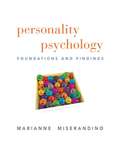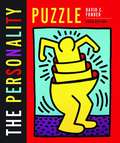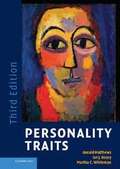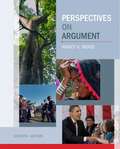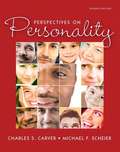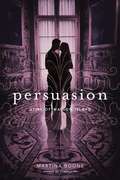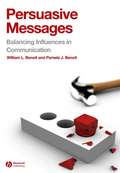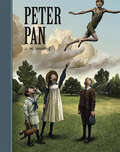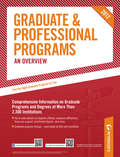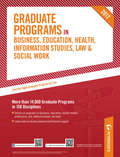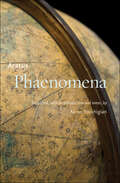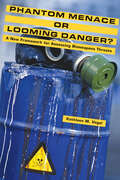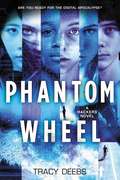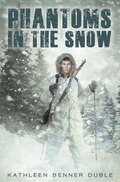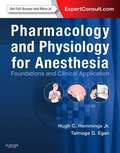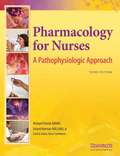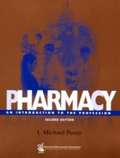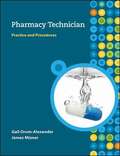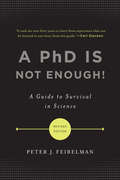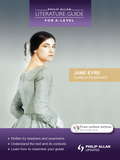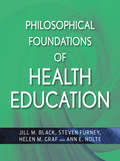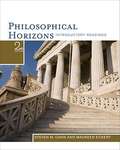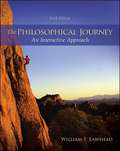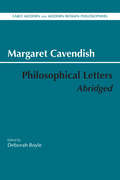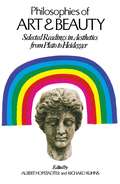- Table View
- List View
Personality Psychology: Foundations and Findings
by Marianne MiserandinoThis book introduces students to the basic foundations and latest findings by presenting the fundamental questions, accumulated knowledge, and latest findings in genetics, neuroscience, traits, self and identity, intrapsychic aspects, regulation, motivation, and cognition, as well as the integration across these areas. Personality Psychology is an undergraduate textbook for personality psychology: the study of individual differences, for identifying ways in which people are both similar and different and for explaining how they became that way. Written with an approachable, story-telling style, the author presents an evidence-based text with integrated culture references and the key building blocks of the subject matter: genetics, neuroscience, and cognition. Miserandino is an APA-award winning teacher and has placed learning tools such as self-assessments within each chapter that guide students into a complete understanding throughout the text.
The Personality Puzzle
by Funder David C.The Personality Puzzle gets students excited about personality psychology, demonstrating that it is relevant to their lives and thus actually fun to explore. Over six editions, author David Funder has established himself as the master of the readable textbook, always conveying the motivations behind psychological inquiry while never skimping on the science.
Personality Traits
by Gerald Matthews Ian J. Deary Martha C. WhitemanNow in its third edition, this dynamic textbook analyses the traits fundamental to human personality: what they are, why they matter, their biological and social foundations, how they play out in human life and their consequences for cognition, stress and physical and mental health. The text also considers the applications of personality assessment in clinical, educational and occupational settings, providing the reader with a detailed understanding of the whole field of personality traits. This edition, now in 2-colour with improved student features, includes the latest research from behavioural genetics, neuroscience, social psychology and cognitive science, assesses the impact of new research techniques like brain imagery, and provides additional content on positive aspects of traits and practical uses of personality assessment. This is an essential textbook for students taking courses in personality and individual differences and also provides researchers and practitioners with a coherent, up-to-date survey of this significant area.
Perspectives on Argument (7th Edition)
by Nancy V. WoodThis combination rhetoric/reader helps readers develop strategies for critical reading, critical thinking, research, and writing that will help the reader argue clearly and convincingly. It teaches them to identify and develop arguments, to read and form reactions and opinions of their own, to analyze an audience, to seek common ground, and to use a wide, realistic range of techniques to write argument papers that express their individual views and original perspectives on modern issues.
Perspectives on Personality (7th Edition)
by Charles S. Carver Michael F. ScheierThis book describes a range of viewpoints that are used by personality psychologists today. Each perspective on personality is presented in a pair of chapters, introduced by a prologue that provides an overview of that perspective’s orienting assumptions and core themes. By starting with these orienting assumptions, you’ll be placed right inside the thought processes of the theorists, as you go on to read the chapters themselves. Each chapter concludes with a discussion of current problems within that theoretical viewpoint and the authors’ analysis about its future prospects. The result is a book that is engaging and enjoyable as well as informative. Learning Goals Upon completing this book, readers should be able to: Identify the ideas that form each theoretical viewpoint Understand the importance of research and why the role of research stresses the fact that personality psychology is a living, dynamic process of ongoing scientific exploration See how each perspective reflects fundamental assumptions about human nature and how behavior problems can arise and be treated from each perspective Understand how the different viewpoints relate to each other and the usefulness of blending theoretical viewpoints, treating theories as complementary, rather than competing.
Persuasion: Heirs of Watson Island (Heirs of Watson Island)
by Martina BooneBeautiful Creatures meets Gone with the Wind in the spellbinding second novel in the Heirs of Watson Island trilogy that “skillfully blends rich magic and folklore with adventure, sweeping romance, and hidden treasure” (Publishers Weekly, on Compulsion).Grieving the death of her godfather and haunted by her cousin Cassie’s betrayal, Barrie returns from a trip to San Francisco to find the Watson plantation under siege. Ghost-hunters hope to glimpse the ancient spirit who sets the river on fire each night, and reporters chase rumors of a stolen shipment of Civil War gold that may be hidden at Colesworth Place. The chaos turns dangerous as Cassie hires a team of archeologists to excavate beneath the mansion ruins. Because more than treasure is buried there. A stranger filled with magic arrives at Watson’s Landing claiming that the key to the Watson and Beaufort gifts—and the Colesworth curse—also lies beneath the mansion. With a mix of threats and promises, the man convinces Barrie and Cassie to cast a spell at midnight. But what he conjures may have deadly consequences. While Barrie struggles to make sense of the escalating peril and her growing feelings for Eight Beaufort, it’s impossible to know whom to trust and what to fight for—Eight or herself. Millions of dollars and the fate of the founding families is at stake. Now Barrie must choose between what she feels deep in her heart and what will keep Watson’s Landing safe in this stunning addition to a series filled with “decadent settings, mysterious magic, and family histories rife with debauchery” (Kirkus Reviews, on Compulsion).
Persuasive Messages: The Process of Influence
by William L. Benoit Pamela J. BenoitWilliam and Pamela Benoit's (both communication, U. of Missouri- Columbia) textbook offers college students practical advice on refining one's purpose, understanding one's audience, and designing a persuasive message. Coverage includes key concepts, sources, and the relationship between attitudes and behavior; the mechanics of creating persuasive messages; theories of persuasion; and the use of persuasion in two particular contexts, advertising and political campaigns.
Peter Pan (Union Square Kids Unabridged Classics)
by J. M. BarrieAll children except one grow up. In 1904, Peter Pan first flew across a London stage and into the bedroom of Wendy, John, and Michael Darling. Ever since, this perpetual youth has continued to delight children of all ages. Young readers will happily soar with him and his friends to enchanted Neverland, where they’ll meet Tinkerbell, the Lost Boys, and the “dark and sinister” Captain Hook. It’s a tale as ageless as its beloved hero.
Peterson's Graduate & Professional Programs: An Overview 2012
by Peterson'SGraduate & Professional Programs: An Overview 2012 contains nearly 2,400 university/college profiles that offer valuable information on graduate and professional degrees and certificates, enrollment figures, tuition, financial support, housing, faculty, research affiliations, library facilities, and contact information. This graduate guide enables students to explore program listings by field and by institution. Two-page in-depth descriptions, written by administrators at featured institutions, give complete details on the graduate study available. Readers will benefit from the expert advice on the admissions process, financial support, and accrediting agencies.
Peterson's Graduate Programs in Business, Education, Health, Information Studies, Law & Social Work 2012
by Peterson'sPeterson's Graduate Programs in Business, Education, Health, Information Studies, Law & Social Work 2012 contains a wealth of info on accredited institutions offering graduate degrees in these fields. Up-to-date info, collected through Peterson's Annual Survey of Graduate and Professional Institutions, provides valuable data on degree offerings, professional accreditation, jointly offered degrees, part-time & evening/weekend programs, postbaccalaureate distance degrees, faculty, students, requirements, expenses, financial support, faculty research, and unit head and application contact information. There are helpful links to in-depth descriptions about a specific graduate program or department, faculty members and their research, and more. Also find valuable articles on financial assistance, the graduate admissions process, advice for international and minority students, and facts about accreditation, with a current list of accrediting agencies.
Phaenomena (Johns Hopkins New Translations from Antiquity)
by AratusAfter the Iliad and the Odyssey, the Phaenomena was the most widely read poem in the ancient world. Its fame was immediate. It was translated into Latin by Ovid and Cicero and quoted by St. Paul in the New Testament, and it was one of the few Greek poems translated into Arabic. Aratus’ Phaenomena is a didactic poem—a practical manual in verse that teaches the reader to identify constellations and predict weather. The poem also explains the relationship between celestial phenomena and such human affairs as agriculture and navigation. Despite the historical and pedagogical importance of the poem, no English edition suitable for students and general readers has been available for decades. Aaron Poochigian’s lively translation makes accessible one of the most influential poets of antiquity. Poochigian's interpretation of the Phaenomena reestablishes the ancient link between poetry and science and demonstrates that verse is an effective medium for instruction. Featuring references to Classical mythology and science, star charts of the northern and southern skies, extensive notes, and an introduction to the work’s stylistic features and literary reception, this dynamic work will appeal to students of Ancient Greece who want to deepen their understanding of the Classical world.
Phantom Menace or Looming Danger?: A New Framework for Assessing Bioweapons Threats
by Kathleen M. VogelCalls for a new way to assess bioweapon threats—recognizing the importance of the sociopolitical context of technological threats.The horrifying terrorist attacks on September 11, 2001, and the anthrax strikes that soon followed gave the United States new reason to fear unconventional enemies and atypical weapons. These fears have prompted extensive research, study, and planning within the U.S. military, intelligence, and policy communities regarding potential attacks involving biological weapons. In Phantom Menace or Looming Danger?, Kathleen M. Vogel argues for a major shift in how analysts assess bioweapons threats. She calls for an increased focus on the social and political context in which technological threats are developed.Vogel uses case studies to illustrate her theory: Soviet anthrax weapons development, the Iraqi mobile bioweapons labs, and two synthetic genomic experiments. She concludes with recommendations for analysts and policymakers to integrate sociopolitical analysis with data analysis, thereby making U.S. bioweapon assessments more accurate. Students of security policy will find her innovative framework appealing, her writing style accessible, and the many illustrations helpful. These features also make Phantom Menace or Looming Danger? a must-read for government policymakers and intelligence experts.
Phantom Wheel: A Hackers Novel
by Tracy DeebsThe digital apocalypse has arrived and the future is here in this addictive technological thriller full of twists and turns. Perfect for fans of Nerve! Being recruited by the CIA to join a top-secret intelligence program should be the opportunity of a lifetime. For Issa, it's a shot at creating a new and better life for herself and her siblings. For clever con artist Harper, it's a chance to bury the secrets of her troubled past and make sure that those secrets stay buried. But for Owen--honor student, star quarterback, and computer-hacking genius--it sounds like a trap. He's right. Owen discovers that instead of auditioning for the CIA, they've all been tricked by a multibillion-dollar tech company into creating the ultimate computer virus. It's called Phantom Wheel, and it's capable of hacking anyone on Earth, anywhere, at any time. And thanks to six teenagers, it's virtually unstoppable. Horrified by what they've done, the hackers must team up to stop the virus before the world descends into chaos. But working together is easier said than done, especially as the lines start to blur between teammate, friend, and more than friend. Because how do you learn to trust someone when you've spent your entire life exploiting that same trust in others?
Phantoms in the Snow
by Kathleen Benner DubleIn this gripping journey, a fifteen-year-old pacifist must decide what he believes as he faces the reality of World War II.The year is 1944, and fifteen-year-old Noah Garrett's parents have died from smallpox. Without any other family nearby, Noah is sent to live with his uncle, whom he has never met, in Camp Hale, Colorado. There is one small problem with this decision: Noah has been raised a pacifist, and Camp Hale is a U.S. military base for a little-known division of winter warfare soldiers called Phantoms. Can a boy who's never seen snow and doesn't believe in war survive among these soldiers?Noah's struggle to resolve his upbringing with the horrors of World War II into a way of life he can believe in takes him on an incredible and riveting journey from the training camp to the frontlines of battle. Based on historical events, the story of Noah and the Phantoms of the Tenth Mountain Division is one of courage and conviction, brotherhood, and the joy in living.
Pharmacology and Physiology for Anesthesia
by Hugh C. Hemmings Talmage D. EganBetter understand the complexities of pharmacology and physiology relevant to your practice with the brand-new medical reference book, Pharmacology and Physiology for Anesthesia. Drs. Hugh Hemmings and Talmage Egan provide the clinical insights you need to effectively administer anesthesia, ensuring patient safety and the most optimal outcomes. Access comprehensive, continually updated research on the physiology of organ systems and clinical topics in the pharmacology of anesthetic drugs. Quickly and easily reference the information you need through user-friendly tables, figures, and algorithms, all presented in lavish full color throughout. Understand the molecular mechanism of drug actions and identify key drug interactions that may complicate anesthesia with dedicated sections on these key areas. Search the text and download images online at Expert Consult. Build a thorough knowledge of pharmacology and physiology focused on clinical practice
Pharmacology for Nurses: A Pathophysiologic Approach (3rd Edition)
by Michael Patrick Adams Leland Norman Holland Jr. Carol Q. UrbanThe third edition of Pharmacology for Nurses: A Pathophysiologic Approach has been thoroughly updated to reflect current pharmacologic drugs and processes. This book is structured to present pharmacology and pathology together, so students can more easily grasp the interrelationship between these subjects and patient care.
Pharmacy: An Introduction to the Profession
by L. Michael PoseyAs editorial director of the APA, Posey updates his 2003 textbook introducing not the technical aspects of pharmacy, but the nature of the profession itself. It supplies core knowledge needed to put information from other courses into perspective, and is best supplements with lectures from pharmacy faculty or administrators. Revisions are based on student and instructor feedback, as well as changes in the profession and recent publications. American Pharmacists Association books are distributed by McGraw-Hill. Annotation ©2009 Book News, Inc., Portland, OR (booknews.com)
Pharmacy Technician: Practice and Procedures
by Gail Orum-Alexander James J. MiznerThe book is intended for entry-level students as well as seasoned learners who want to prepare themselves for the pharmacy technician profession.
A PhD Is Not Enough!: A Guide to Survival in Science
by Peter J. FeibelmanDespite your graduate education, brainpower, and technical prowess, your career in scientific research is far from assured. Permanent positions are scarce, science survival is rarely part of formal graduate training, and a good mentor is hard to find. InA Ph. D. Is Not Enough!, physicist Peter J. Feibelman lays out a rational path to a fulfilling long-term research career. He offers sound advice on selecting a thesis or postdoctoral adviser; choosing among research jobs in academia, government laboratories, and industry; preparing for an employment interview; and defining a research program. The guidance offered inA Ph. D. Is Not Enough!will help you make your oral presentations more effective, your journal articles more compelling, and your grant proposals more successful. A classic guide for recent and soon-to-be graduates,A Ph. D. Is Not Enough!remains required reading for anyone on the threshold of a career in science. This new edition includes two new chapters and is revised and updated throughout to reflect how the revolution in electronic communication has transformed the field.
Philip Allan Literature Guide (for A-Level): Jane Eyre
by Anne Crow Nicola OnyettFor study or revision, these guides are the perfect accompaniment to the set text, providing invaluable background and exam advice.Philip Allan Literature Guides (for A-level) offer succinct and accessible coverage of all key aspects of the set text and are designed to challenge and develop your knowledge, encouraging you to reach your full potential.Each full colour guide:Gives you the confidence that you know your set text inside out, with insightful coverage for you to develop your understanding of context, characters, quotations, themes and styleEnsures you are fully prepared for your exams: each guide shows you how your set text will be measured against assessment objectives of the main specificationDevelops the skills you need to do well in your exams, with tasks and practice questions in the guide, and lots more completely free online, including podcasts, glossaries, sample essays and revision advice at www.philipallan.co.uk/literatureguidesonline
Philosophical Foundations of Education (9th Edition)
by Howard A. OzmanNow in its ninth edition, Philosophical Foundations of Education provides readers with comprehensive knowledge about the various schools of thought that have comprised the philosophy of education throughout history. Highly readable, this chronological text gives insight into the individuals who helped develop various philosophies of education and provides historical information about how they lived and how they learned. In addition, each chapter covers each philosophy’s aims, methods, curriculums, teaching roles, advantages, and disadvantages. Covering not only how each philosophy evolved over time but also how these philosophies influenced subsequent educational practice, this popular textbook also challenges readers to apply what they have learned in their own profession and develop their own philosophies about education, instruction, and schooling.
Philosophical Horizons: Introductory Readings
by Steven M. Cahn Maureen EckertExplores the central issues of philosophy through an engaging combination of classic and contemporary sources. With over seventy non-technical readings, the editors of PHILOSOPHICAL HORIZONS have put together the easiest to follow and yet most informative philosophy selections ever. Unlike any other introductory anthology, you can read fully annotated masterpieces from the history of philosophy in their entirety, including Plato's Euthyphro, Apology, and Crito, the Encheiridion of Epictetus, Descartes's Meditations, Berkeley's Treatise, Hume's An Enquiry Concerning Human Understanding and Dialogues Concerning Natural Religion, Kant's Groundwork, Mill's Utilitarianism, James's The Will to Believe, and Sartre's The Humanism of Existentialism. These are juxtaposed with related work from contemporary philosophers so that you can experience how the issues raised in these classic works of philosophy are debated in contemporary times.
The Philosophical Journey: An Interactive Approach (Sixth Edition)
by William LawheadThe Philosophical Journey: An Interactive Approach is a text with readings that enhances comprehension of philosophical study by encouraging students to ponder, explore, and actively participate in the learning process. Philosophy becomes a personal journey for students through Lawhead's unique pedagogy that introduces philosophical concepts through practical application in the form of primary sources, interwoven exercises, and sections that encourage critical thinking and further exploration of core concepts.
Philosophical Letters, Abridged (Early Modern and Modern Women Philosophers)
by Margaret Cavendish"Margaret Cavendish (1623–1673) is a fascinating figure who is getting increasing attention by historians of philosophy these days, and for good reason. . . . She&’s an interesting advocate of a vitalist tradition emphasizing the inherent activity of matter, as well as its inherent perceptive faculties. She&’s also the perfect character to open students (and their teachers) up to a different seventeenth century, and a different cast of philosophical characters. This is an ideal book to use in the classroom. The Philosophical Letters (1664) gives us Cavendish&’s view of what was interesting and important in the philosophical world at that moment, a view of philosophy as it was at the time by an engaged participant. There are few documents like it in the history of philosophy. Deborah Boyle&’s Introduction provides a very accessible summary of Cavendish&’s natural philosophy, as well as good introductions to the other figures that Cavendish discusses in the book. Boyle&’s annotations are not extensive, but they are a great help in guiding the student toward an informed reading of the texts." —Daniel Garber, Princeton University
Philosophies of Art and Beauty: Selected Readings in Aesthetics from Plato to Heidegger
by Albert Hofstadter Richard KuhnsThis anthology is remarkable not only for the selections themselves, among which the Schelling and the Heidegger essays were translated especially for this volume, but also for the editors' general introduction and the introductory essays for each selection, which make this volume an invaluable aid to the study of the powerful, recurrent ideas concerning art, beauty, critical method, and the nature of representation. Because this collection makes clear the ways in which the philosophy of art relates to and is part of general philosophical positions, it will be an essential sourcebook to students of philosophy, art history, and literary criticism.
